作物水分生产函数研究进展*
2018-11-29李中恺赵文智
李中恺, 刘 鹄, 赵文智
作物水分生产函数研究进展*
李中恺1,2, 刘 鹄1**, 赵文智1
(1. 中国科学院西北生态环境资源研究院/中国生态系统研究网络临泽内陆河流域研究站/中国科学院内陆河流域生态水文重点实验室 兰州 730000; 2. 中国科学院大学资源与环境学院 北京 100049)
作物水分生产函数(crop water production functions, CWPF)一般指作物产量(crop yield,)与蒸散发(evapotranspiration, ET)之间的函数关系, 是作物模型中联系水分和生产力的关键。本文系统地梳理了近半个世纪以来CWPF的相关研究, 发现CWPF受多种因素影响, 不同地区获得的田间试验结果往往差异较大; 常用的CWPF模型多是基于统计信息, 缺少坚实的物理基础和可靠的理论支撑, 在跨地区、跨物种应用时存在一定缺点。同时基于碳同化过程的机制模型和更为复杂的作物模型也因为参数过多而不易在实际中应用。在以往研究的基础上, 从公开发表的41篇文献中筛选出592组田间试验数据, 发现小麦产量与ET基本呈线性关系, 但数据分布相对离散, 而玉米、棉花、水稻因数据量较少其产量与ET关系不明显。利用生长季降水量和累计蒸发皿蒸发数据对不同地区获得的小麦水分生产函数进行了修正, 发现改进后的小麦水分生产函数表现出较好的跨地区应用潜力(2从0.36提高到0.75), 并提出了进一步的CWPF修正思路。指出通过改进函数关系虽然能提高统计模型的可移植性, 但发展机制模型仍是未来CWPF研究的根本出路。
水分生产函数; 作物蒸散发; 作物产量; 荟萃分析; 模型修正
作物水分生产函数(crop water production functions, CWPF)指作物产量(crop yield,)与耗水量之间的函数关系[1], 是作物模型中联系生产力(crop productivity)与水分因子的关键和纽带[2]。CWPF中产量一般指单位面积耕地所收获的有经济价值的主要产品总量, 如谷类、豆类作物的子实, 棉花(L.)的籽棉、皮棉等[3]; 而水分因子则可以是灌溉量(irrigation,)、土壤水分储量(soil water storage,)、蒸腾量(transpiration,)以及蒸散发量(evapotranspiration, ET)等。受深层渗漏和土壤水分再分配过程影响, 灌溉量和土壤水分储量变化并不能精确地反映作物耗水情况, 在某些地区甚至与真实作物耗水量相差巨大[4], 因此常用ET做CWPF的水分变量。
在全球人口增长、水资源和粮食安全面临挑战的背景下, 如何用更少的水生产更多的粮食, 成为人类面临的重大问题[5-6]。CWPF是制定农业节水灌溉策略、分析灌水效益的重要依据, 基于CWPF的灌溉策略可在保证作物产量的前提下避免资源浪费[7], 有效提高农业水利用效率(/ET)[8], 如Chemin等[9]与Bastiaanssen[10]利用遥感影像反演的蒸散发数据分析当地灌溉效率及作物水分胁迫情况以制定最优灌溉制度; Tasumi等[11]通过量化蒸散量来分析种植时间对不同作物产量和生长状态的影响等。因此, CWPF一直是农业生产与水资源管理领域的研究热点[12]。
国外关于CWPF的研究可追溯到20世纪50年代Allison等[13]针对水稻(L.)开展的工作。De Wit[14]从理论上讨论了蒸腾过程与产量的关系, 之后出现了大量针对不同作物、不同栽培方式、不同灌溉模式等的田间耗水试验。这些试验以小麦(L.)、玉米(L.)为主, 也涉及水稻、棉花、西红柿(Mill.)、马铃薯(L.)、洋葱(L.)、甜菜(L.)、胡椒(L.)、苜蓿(L.)、高粱(L.)等其他作物。由于CWPF受到多种因素的影响, 不同地区的试验结果往往差异很大, 因此这些研究结果很难移植到其他地区。文献中关于CWPF的模型大致有3类: 1)基于气孔扩散理论的机制模型, 2)基于田间试验数据的统计模型, 3)以前两类模型为基础发展起来的作物模型。3类模型都有其不可避免的缺点, 机制模型或更为复杂的作物模型由于参数较多, 不便于实际应用, 而基于观测数据的统计模型又很难跨地区移植。
国内对CWPF的研究始于20世纪80年代[15], 先后在不同地区, 针对不同作物开展了大量专项试验, 并在经典模型的解释、算法的改进、参数的时空变化规律、不同模型在同一地区的适用性比较等方面取得了大量进展[16-19], 这些工作提高了对作物产量与水分消耗关系的认识, 并为局地产量预测与灌溉系统优化设计起了指导作用[15]。尽管国内外均对CWPF进行了大量研究, 但从现有文献来看, 目前仍缺乏简单可靠、有坚实物理基础、可方便移植到不同地区的CWPF模型。本文从理论研究、数学模型和田间试验3个方面系统阐述了CWPF研究进展, 并通过对CWPF田间试验数据进行挖掘和梳理, 在已有的CWPF模型基础上, 提出基于蒸发皿蒸发(evaporation,)和降雨量的CWPF修正方案。
1 作物水分生产函数理论研究
1.1 理论基础
作物水分生产函数(CWPF)本质上反映了作物通过耗水生产干物质的能力[1]。作物根系从土壤吸收的水分绝大部分(99%)以叶面蒸腾(transpiration,)的形式消耗[20]。气孔是叶面蒸腾的主要途径: 作物生长过程中, 叶片打开气孔进行CO2同化, 水分也随之从气孔扩散到大气。因此, 作物产量的形成基本以蒸腾为代价[21](图1)。当作物受到水分胁迫时, 气孔逐渐关闭, 蒸腾速率与光合速率同时下降[22], 可见气孔行为是控制作物生产及水分消耗的核心机制[21]。同一物种在同一地区、相同生长阶段的蒸腾效率(TE, 生物量积累与蒸腾量比率[23])从细胞、叶面到冠层尺度上基本不变[24], 而生物量与产量之间又存在一定的相关性, 因此田块水平上蒸腾与产量()之间也存在较为稳定的函数关系[25](=×TE×HI, 其中HI为收获指数)。考虑到土壤蒸发与作物蒸腾往往同步发生, 很难利用观测手段将其单独量化, 因此蒸散发是反映作物产量与水分关系的最佳变量[26], 而CWPF通常也被简化为作物产量与蒸散发(ET)关系(图1)。

图1 作物水分生产函数(CWPF)发生机制示意图
表示蒸腾占蒸散发的比例, TE与HI分别为蒸腾效率及收获指数。indicates the ratio of transpiration to evapotranspiration, TE and HI are transpiration efficiency and harvest index, respectively.
1.2 影响因素
不同地区田间试验得到的CWPF往往差异较大。以棉花和西红柿为例, Grimes等[27]、Howell等[28]发现棉绒产量与蒸散发之间为二次函数(quadratic)关系, 而Hunsaker等[29]在试验中得出棉绒产量与蒸散发为线性关系; Zheng等[30]、Kuşçu等[31]发现西红柿产量与生长季蒸散发数据可用线性关系拟合, 而Patanè等[32-33]发现西红柿产量与蒸散发数据用二次函数关系拟合更优。从田间试验得到的大量资料表明, CWPF易受作物种类、气候、灌溉模式、土壤类型、耕作方式(农艺)、施肥管理、遗传特性及地下水位等多种因素的影响[34-41], 同时坡度、耕作层深度甚至灌溉水水质也会间接影响CWPF[42-44],其函数关系可概括为:
=(ET,,,,,,) (1)
式中:表示气候条件(climate),表示灌溉水平(irrigation),表示作物品种(variety),表示施肥情况(fertilization),表示土壤类型(soil),代表其他轻微影响CWPF的因子。此外, 作物的自适应特性可以抵消小部分环境变量对CWPF的影响, 如轻微干旱胁迫能促进作物根系生长, 缓解干旱导致的水分亏缺影响[45]。
在众多影响因素中, 灌溉和施肥等属于人为可调控因素, 而气候条件与土壤类型属于不可控因素。对于可控因素, 通过合理的农业管理措施可以将其控制在理想状态, 从而使其对CWPF的影响降到最低, 如可以用同一地区的最大产量和相应的蒸散发反映一个地区的生产力水平[46]。对于不可控因素, 则需要更多的地区性经验来获得当地CWPF, 这造成了很多不便, 因此地区可移植性一直是CWPF研究的重点内容[47]。
2 作物水分生产函数模型研究进展
2.1 基于田间试验(资料)的统计模型
此类模型多为经验或半经验模型, 通过对试验数据的回归分析得到, 描述作物最终产量和生长季蒸散发之间的统计关系。根据生长阶段的划分与否, 可分为全生育期模型和生长阶段模型, 前者可分为线性与非线性模型, 后者可分为连加与连乘模型(表1)。
2.1.1 全生育期线性模型
全生育期CWPF线性模型的数学式可表达为:=+×ET(为参数)。在一定条件下, 多数作物的产量与其生长季蒸散发都可用线性函数表示。Stewart等[48]对上式进行了改进, 提出了经典统计模型Stewart S-1模型

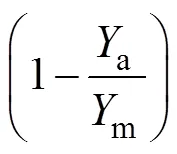

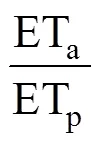
Rajput等[52]认为土壤和气候条件是造成Stewart S-1模型在不同地区产生偏差的主要原因, 并给出了Stewart S-1模型的y表达:
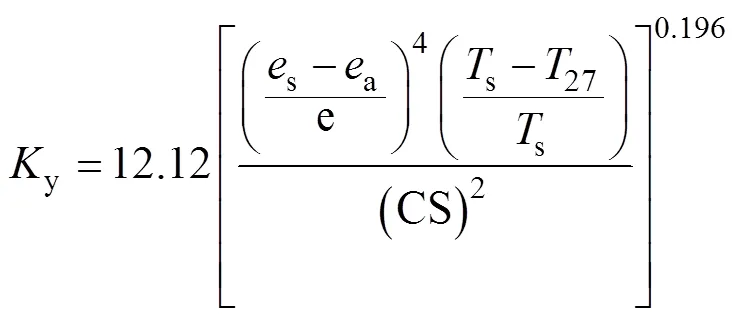
式中:s为平均饱和水汽压;a为平均实际水汽压;s为作物生育期(d);27为最高气温低于27 ℃的天数; CS为作物根区黏土百分比(代表土壤的持水能力)。
此外还有一些经典全生育期线性模型直接用作物蒸腾()而非蒸散发(ET)做自变量, 如Ngigi[53]、Hanks[54], 而De Wit[14]使用水面蒸发0代替最大蒸腾m来对产量进行拟合(见表1)。
2.1.2 全生育期非线性模型

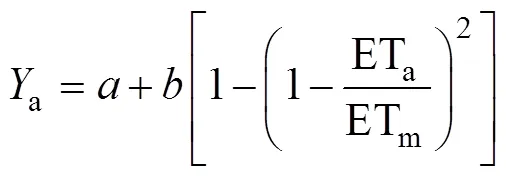
式中:a为作物的实际产量,为经验系数。Liu等[56]也提出了类似的模型(表1)。此外, Vico等[58]提出了一个新模型来拟合玉米、小麦产量与蒸散发之间的非线性关系:

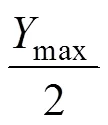
2.1.3 生长阶段连加模型
作物产量不仅取决于全生育期总的水分供给(生长季蒸散发), 也取决于供水量在各生长阶段的分配[49]。康绍忠等[59]研究发现, 相比水分亏缺量, 水分亏缺出现时间对作物产量影响更大。生长阶段模型以作物各生育阶段的相对蒸散发为自变量, 体现了作物各生育阶段水分亏缺与作物产量之间的关系, 根据模型的数学表达形式又可分为连加模型和连乘模型两类。连加模型假定作物不同生长阶段ET亏缺对产量的影响可以相加。
生长阶段连加模型以Stewart S-2模型[48](公式7)和Blank模型(公式8)[59]为代表:

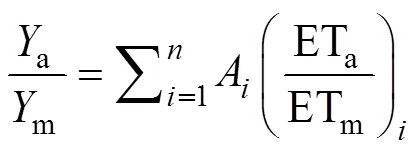
式中:K与A是经验系数, 反映不同生长阶段()作物对水分亏缺的敏感程度, 表达不同生长阶段缺水对作物最终产量的影响程度。常用的生长阶段连加模型还有Singh[59]、Howell[60]、Rao-1[50]以及Rajput[52]等(表1), 此外也有连加模型将ET用·的形式表达, 如Paredes模型[61]:

式中:v、f、m分别表示作物营养生长期、开花期、成熟期蒸腾量, d表示水分亏缺程度(deficit),c表示最大作物蒸腾量。
2.1.4 生长阶段连乘模型
生长阶段连乘模型用各生长阶段相对蒸散发的积表达不同生长阶段水分状况对产量形成过程的影响。在众多连乘模型中, Jensen[62](公式10)与康绍忠等[59](公式11)最具代表性, 我国应用也较为广泛:
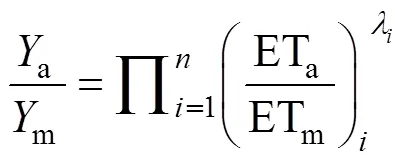

式中:λ与δ为不同生长阶段()作物水分胁迫敏感指数(moisture sensitivity index)。常用的生长阶段连乘模型还有Rao2、Hanks-1等(表1), De Jager[63]在前人的基础上, 结合连加与连乘模型, 提出了一个日尺度的CWPF模型:

式中:c为作物实际产量,mc为最大潜在产量,yc,g为作物c在生长阶段的响应因子, ETac,g为作物c在生长阶段的日实际蒸散发, ETmc,g为作物c在生长阶段的日最大蒸散发。
2.2 基于气孔扩散理论的机制模型
气孔是作物与大气之间进行水分和CO2交换的共同通道, 植物通过调节气孔的开度控制水分耗散和碳同化过程, 因此蒸腾作用与光合过程同步发生。通过基于叶面尺度气孔扩散理论的碳水关系模型(如Jarvis[21]、Farquhar[64]、Leuning[65]等)可方便地建立起生物量与蒸腾过程之间的关系, 然后利用净辐射在冠层潜热和感热之间的分配关系, 以及产量与生物量之间的经验关系(如收获指数HI), 再通过升尺度方法并利用SPAC理论耦合土壤水分动态, 就能间接实现CWPF的推算, 多数已有的SPAC模型(如Daly[66]、Jensen[67]、Tuzet[68]等)都基本能满足这样的需要。
Feddes[38]在研究农田水分运动及作物产量的模拟中, 分析了作物干物质形成过程的特点, 提出干物质日形成率的计算式:



2.3 基于统计或机制模型的复杂作物模型
2.3.1 基于CWPF统计模型的作物模型
在上述统计模型的基础上, 发展出了一些更为复杂、涉及参数更多的作物模型, 如SIMDualKc作物模型就是先使用双作物系数法分别计算蒸腾和蒸发, 再使用Stewart统计模型[48](S-1和S-2)预测作物产量[69]; 著名的FAO的作物模型AquaCorp[70]也是在Doorenbos统计模型[51]的基础上加入了水生产力参数(WP)和收获指数(HI)来估算作物产量:
=WP×(15)
=×HI (16)
式中:为生物量,为实际作物蒸腾,为作物最终产量。这些模型在已有CWPF统计模型的基础上加入了水分平衡和作物生长模块, 应用较为广泛。但也有存在相应的缺点, 如参数过多(AquaCorp模型需33个参数), 没有考虑养分条件的限制等。
2.3.2 基于CWPF机制模型的作物模型
另外一些常见的作物模型则基于CWPF机制模型来计算产量: RS-P-YEC模型(Remote-Sensing– Photosynthesis–Yield Estimation for Crops)[71]通过叶片瞬时光合作用的积分得到叶片日总碳同化量, 根据叶片受光条件获取冠层尺度的碳同化量, 减去作物自养呼吸后得到作物净初级生产力(NPP), 再将NPP与HI相乘得到作物产量, 在此基础上使用卫星反演模块计算的蒸散发数据就可以方便地获得CWPF; SUCROS模型(Simple and Universal Crop Growth Simulator)则利用冠层同化速率、蒸腾作用、呼吸作用及干物质分配系数计算产量, 得到潜在蒸散与潜在产量的关系, 然后通过Penman公式和叶面积指数(LAI)计算潜在蒸发蒸腾进而获得作物潜在产量[72]; WOFOST模型(WOrld FOod STudies)[73]在SUROS模型[72]基础上, 考虑了气孔导度(stomatal conductance)与蒸腾及光合速率之间的线性关系, 使用实际蒸腾速率计算碳同化速率, 获得水分限制条件下的实际CWPF。
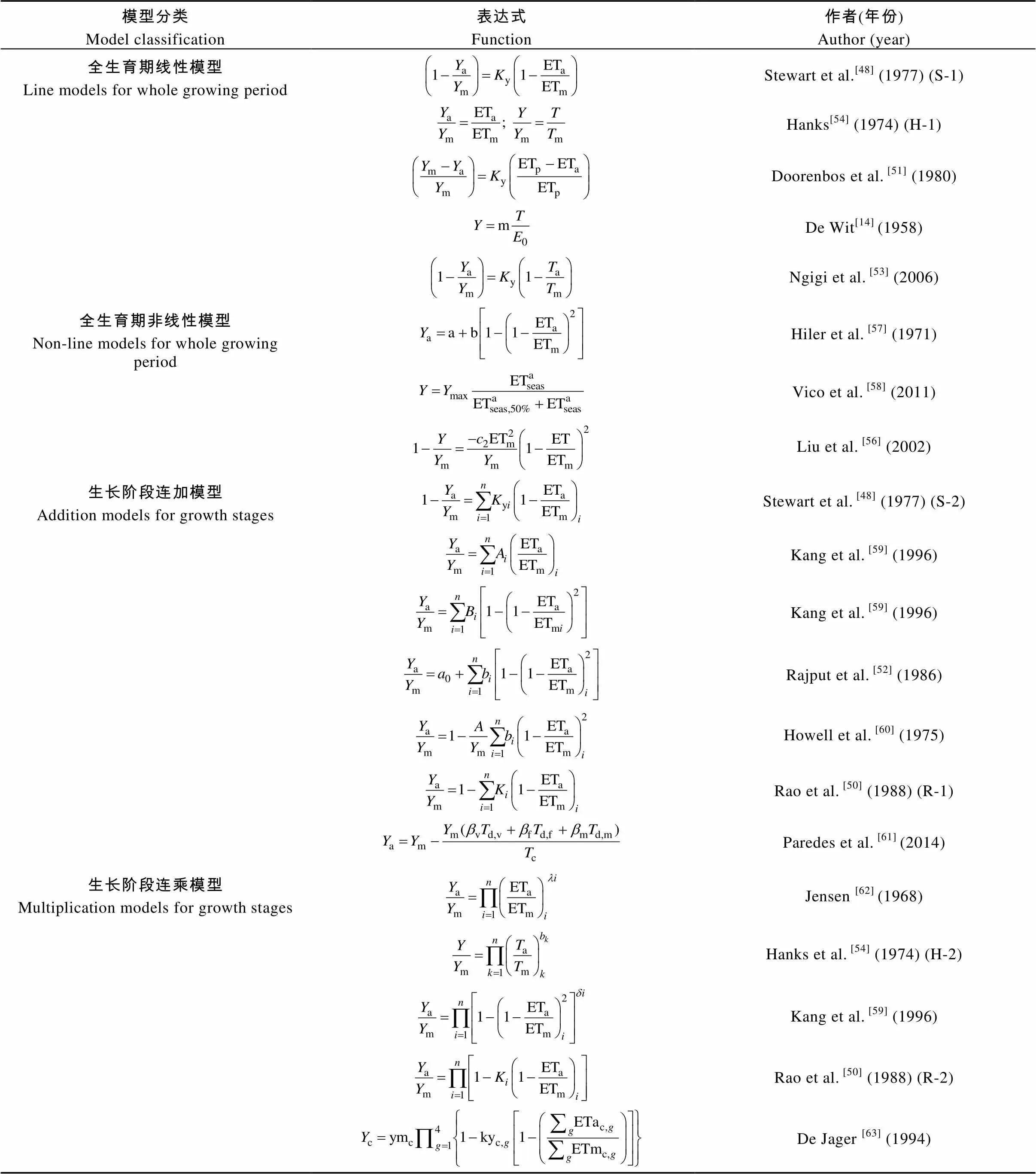
表1 典型CWPF统计模型(1958—2014年)
2.4 CWPF模型优劣分析
统计模型建立在大量田间试验资料基础上, 其中线性模型适用于水分胁迫环境, 而非线性模型适用于充分灌溉环境[59]。连加模型反映了水分胁迫在不同生长阶段对作物生长的影响, 但无法反映某阶段受旱对整个生育期的影响; 连乘模型在一定程度上克服了上述不足, 因而更适合在干旱半干旱地区使用。上述统计模型虽然在形式上存在差异, 但其基本原理都是将田间试验数据进行标准化、弱化离散程度, 进而拟合出理想的产量-蒸散发量(耗水量)关系(CWPF)。其优点是计算简单, 所需数据类型少, 在同一地区能够较为准确地反映作物产量对水分因子的响应特征[47]。但存在一定的地域限制, 通常不能进行跨地区、跨物种推广。机制模型从作物水分生理角度出发模拟作物生长过程(包括同化、吸收及蒸腾过程), 根据作物生长情况逐时段模拟和预测干物质积累, 进而预测作物产量的形成。与统计模型相比, 机制模型的地区可移植性更好。作物模型综合考虑了各种因素对作物产量的影响, 适用于不同地区、时间和品种。机制模型与作物模型可在不同地域不同气候条件下较为成功地体现产量-蒸散发关系(CWPF), 但又往往需要气象、土壤、作物及水文等多种类型的参数, 部分参数又很难通过观测获得, 模型计算过程相对复杂, 导致应用门槛较高。为了建立一种简单可靠, 但又有一定物理基础、可跨地区、跨物种应用的CWPF模型, 本文选择应用更为广泛、结构相对简单的统计模型进行修正, 从影响CWPF的主要因素入手, 尝试克服统计模型无法跨地区应用的缺点。
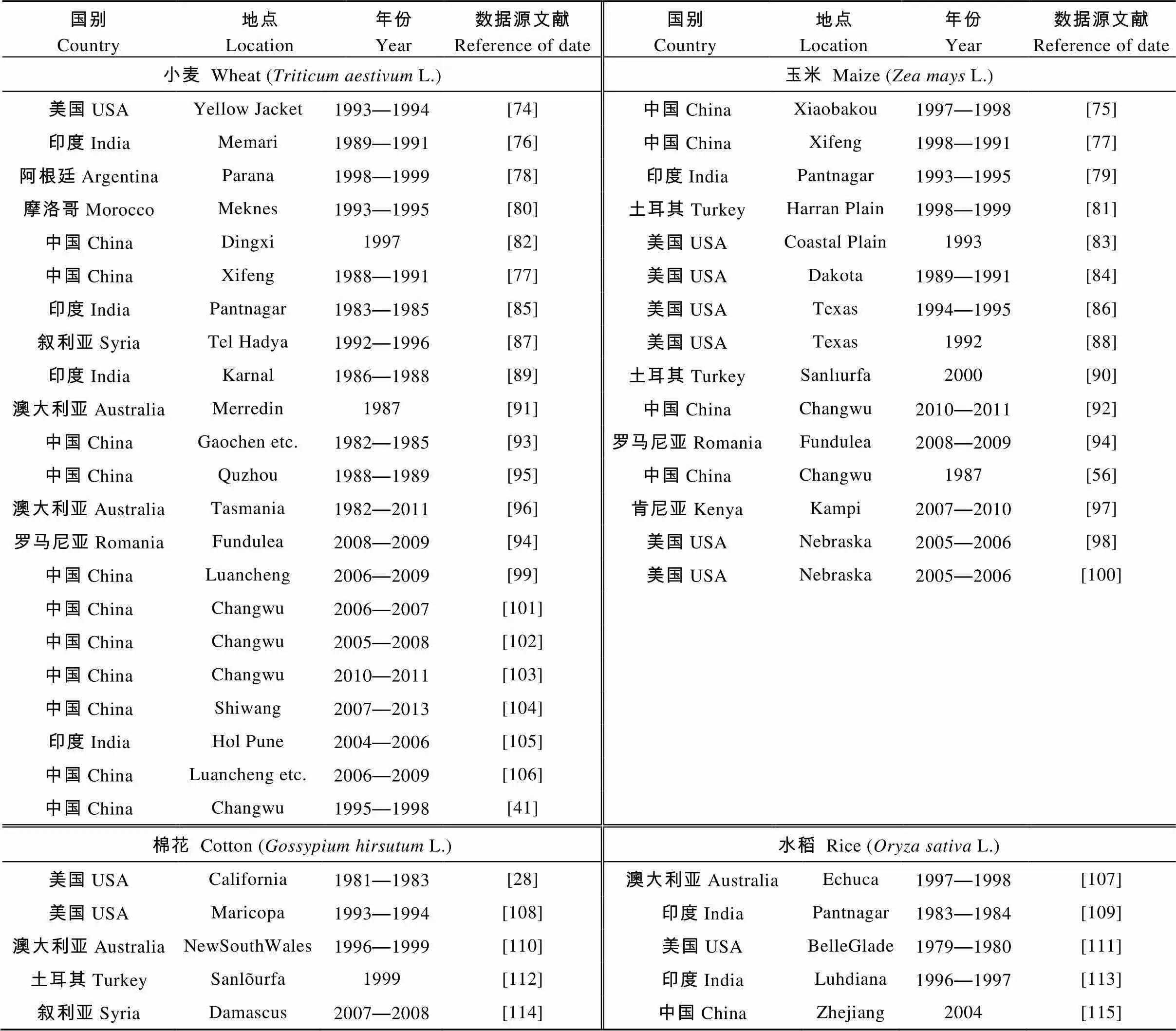
表2 产量-蒸散发(Y-ET)数据集荟萃分析源文献(1979—2013年)
3 作物水分生产函数模型修正
3.1 数据提取
从近50年来公开发表的国际期刊(SCI)中提取了小麦、玉米、棉花、水稻4种作物的CWPF田间试验数据(均为论文原始数据), 在剔除温棚试验、产量与蒸散发量不在同一地点测量等数据后, 从41篇文献中(表2)筛选出592组-ET有效数据, 以及试验地点经纬度、海拔、作物品种、降雨量、灌溉量、耕作方式(包括施肥设计)等基本数据, 另外尽可能收集了蒸发皿蒸发、土壤类型、灌溉方式、地下水水位等重要信息, 在此基础上建立了产量-蒸散发田间试验数据集, 并通过荟萃分析对CWPF进行了修正。数据集中蒸散发量一般采用水平衡公式、Penman-Monteith公式、称重式蒸渗仪、双作物系数法等计算, 产量则主要使用烘干法测量(表2)。
3.2 数据分析
小麦ET数据总体上基本呈线性关系(2=0.34), 其产量随蒸散发增加而增加, 但数据分布相对离散(图2); 玉米ET数据尽管在单个试验中基本呈线性, 但整体上趋势不明显, 且数据分布更加离散(图2); 因数据量的限制, 棉花皮棉产量(lint yield)、籽棉产量(seed yield)及水稻产量与蒸散发关系并不明显(图2)。将小麦和玉米的ET数据通过Stewart S-1模型[48]做标准化处理之后发现只有小麦总体线性关系明显(2=0.42), 玉米线性关系较差(r=0.19), 但这种方法处理后数据离散(图3), 可见传统CWPF统计模型存在明显的地区局限性。
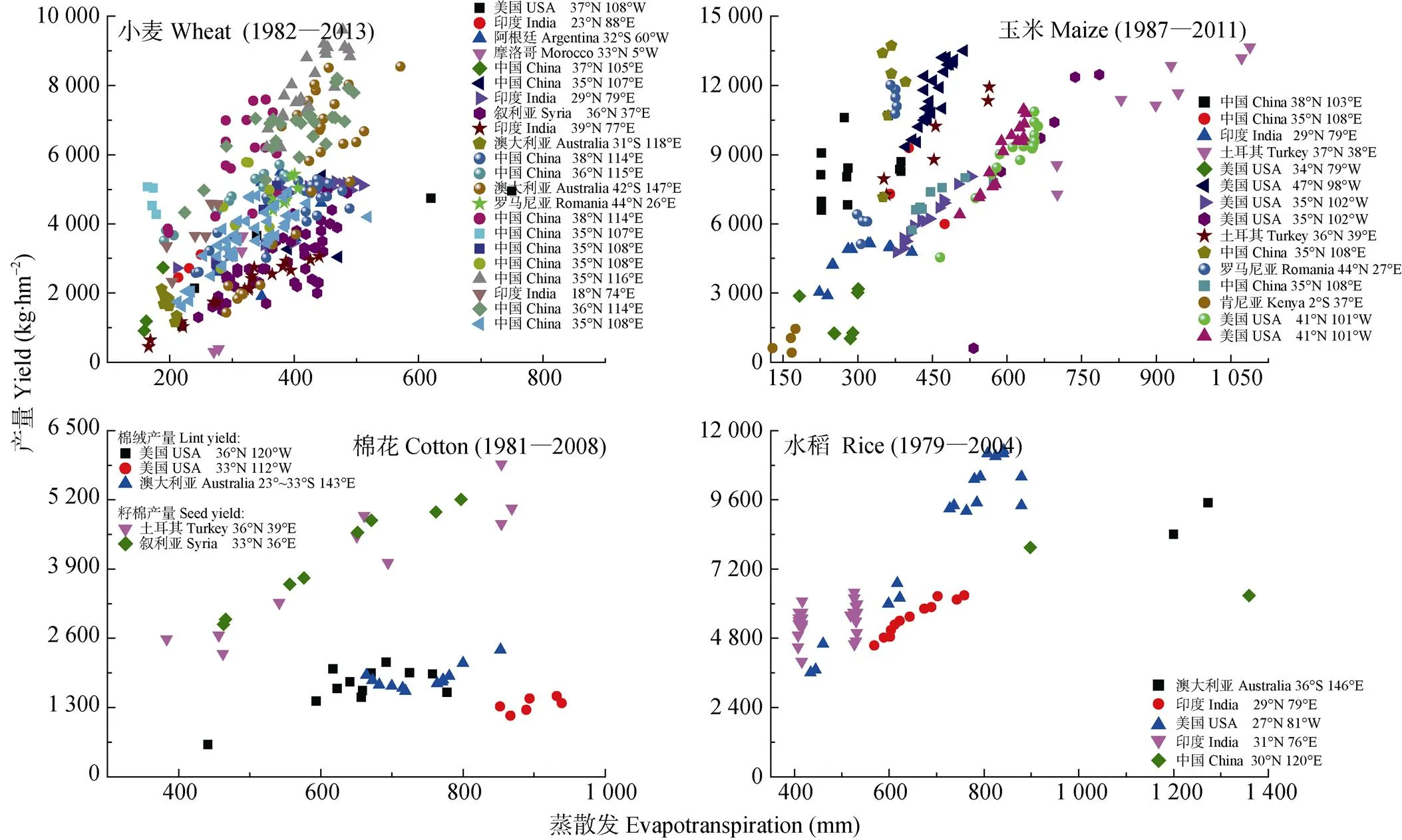
图2 小麦、玉米、棉花、水稻的产量-蒸散发(Y-ET)关系(CWPF)数据集
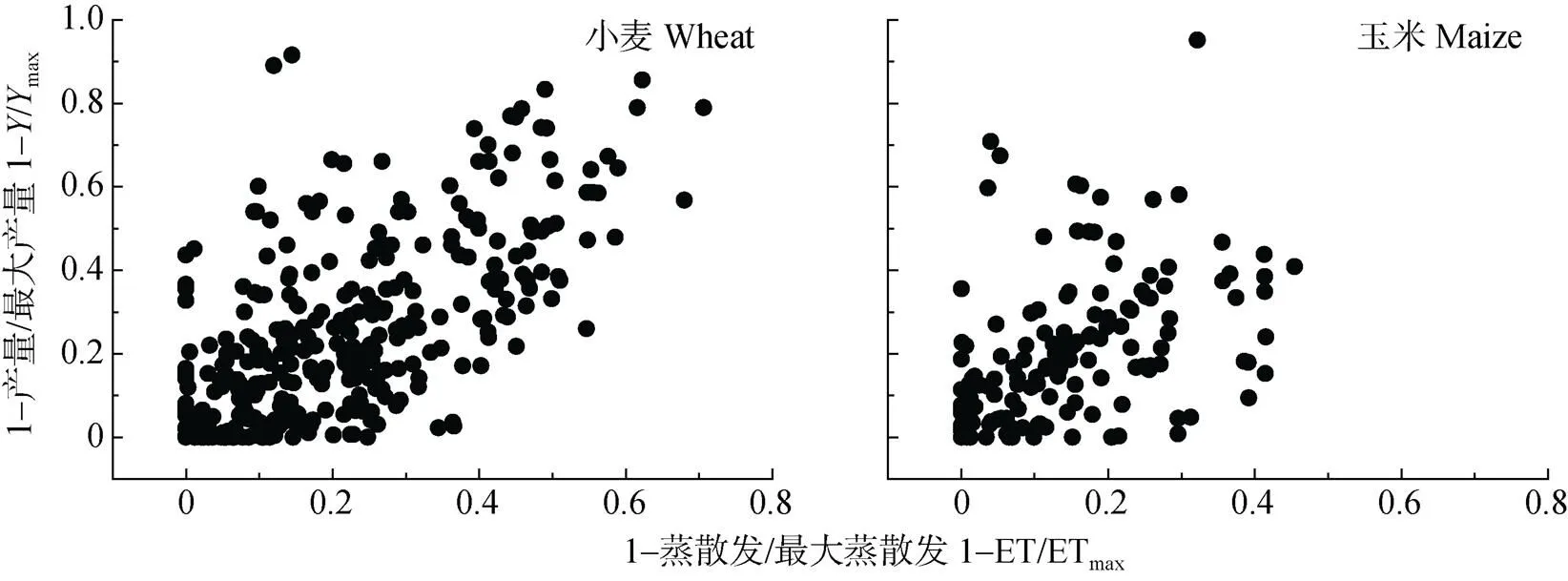
图3 小麦、玉米产量-蒸散发(Y-ET)关系(CWPF)标准化(Stewart S-1模型)
“1产量最高产量”与“1蒸散发最大蒸散发”代表各试验的相对减产与相对蒸散发亏缺。1-maxand 1-ETETmaxrepresent relative yield reduction and relative evapotranspiration deficit of each experiment, in whichandmaxare yield and max yield, ET and ETmaxare evapotranspiration and max evapotranspiration.
3.3 CWPF统计模型修正
尽管以Stewart为代表的统计模型在单个试验中表现良好, 但其很难将不同地区不同年份的-ET数据标准化为理想的线性或抛物线关系。气候因子如环境温度(emp)、辐照度()、降水(rec)和空气水汽压差(VPD)通过影响气孔导度控制植物水分状态[116], 进而影响蒸腾过程和光合作用[117], 因此气候差异是限制CWPF统计模型跨地区使用的主要障碍[14,51-52]。考虑到环境温度、辐照度、降水量对CWPF的影响可以通过干旱指数体现[如标准化降水指数(SPI)[118]、标准化降水蒸散发指数(SPEI)[119]、SPEI-Pe指数等[120]]; 空气水汽压差对CWPF的影响又可以用经验系数来修正[121-122]。本文采用了生长季降水量(rec)与蒸发皿蒸发(Pan)的比(rec/Pan)来反映当地的干旱程度(蒸发皿蒸发包含了水汽压差的信息), 然后将作物实际蒸散发乘以当地“干旱系数”, 得到修正后的CWPF[即(ET´rec/Pan)与的关系], 并对其进行了检验。受数据集的限制(41篇文献中只有7篇小麦参考文献包含当年生长季降雨与蒸发皿蒸发数据), 本文只针对小麦水分生产函数进行了修正和检验, 发现通过rec/Pan对小麦水分生产函数进行修正后, (ET´rec/Pan)与相关性很高(2=0.75), 其中异常值的出现是因为极端干旱事件延迟了当年生长季开始时间[80](图4)。
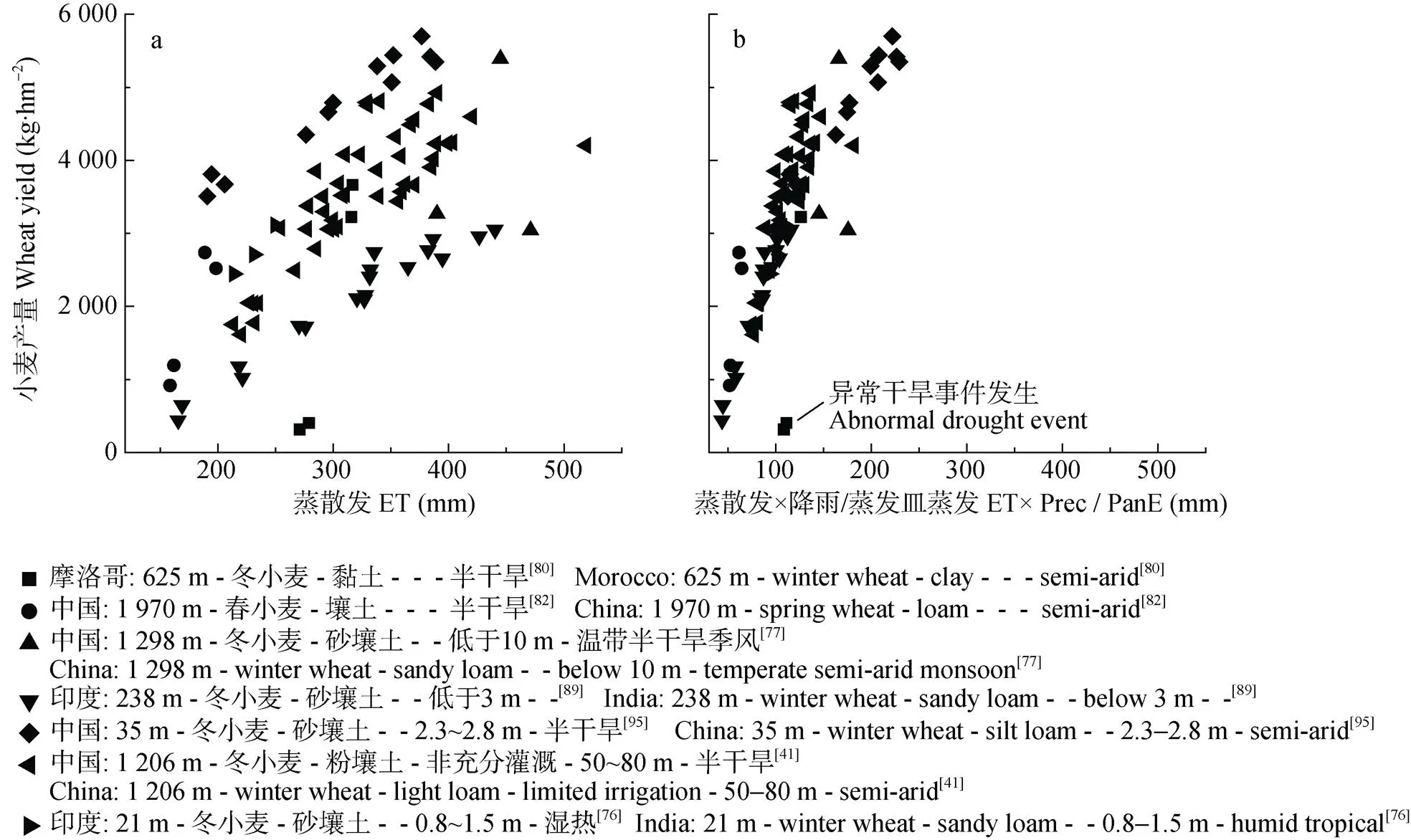
图4 小麦水分生产函数的修正效果[a. 产量与蒸散发的关系(r2=0.36); b: 产量与降水量(Prec)和蒸发皿蒸发(EPan)修正的蒸散发(ET´Prec/EPan)的关系(r2=0.75)]
下方图例依次为国家: 海拔-小麦播种季-土壤类型-灌溉方式-地下水位-气候及文献。The legends are shown in the order of “country: elevation-wheat planting season-soil type-irrigation method-groundwater table-climate-journal article”.
3.4 结果与讨论
尽管各试验地点在气候状况、经纬度、海拔、播种季节、土壤类型、灌溉方式以及地下水位等条件上差异巨大, 但通过当地降雨量(rec)和蒸发皿蒸发(Pan)修正后, ET´rec/Pan与线性关系明显(图4), 表明rec/Pan可以将上述条件差异大部分消除。实际上, ET´rec/Pan=rec´(/Pan+/Pan), 采用蒸发皿蒸发(Pan)来修正CWPF, 相当于用(蒸腾)/Pan标准化-关系(TE)的同时用/Pan弱化了(蒸发)的差异, 从而使得-ET关系(CWPF)得到了显著改善。对而言, 由于水汽压差是影响蒸发皿蒸发的直接因素, 所以使用Pan对进行校正(/Pan)在一定程度上和Tanner等[24]使用季节平均蒸汽压对蒸腾效率(TE)进行矫正效果类似, 矫正后的-关系相对稳定。对而言, 由于蒸发皿蒸发可以综合反映区域潜在蒸发水平, 因此用/Pan相当于弱化了不同地区的差异对CWPF的影响; 而乘以rec相当于弱化了土壤差异造成的水分差异(生长季降雨量在一定程度上对土壤水分进行了有效补充, 故降水量与产量呈正比)。因此, 用降雨量(rec)和蒸发皿蒸发(Pan)修正后的CWPF线性相关性强烈。
此外, 我们发现尽管这7个田间试验有不同水平的氮肥、磷肥使用量, 但用干旱系数修正后CWPF依然表现良好。实际上, 施肥对CWPF的影响往往和土壤水分含量密切相关, 肥料只有溶于土壤水溶液中才能被作物根系吸收利用。在水分受限环境下, 施肥对产量影响有限, 而在水分供给充分时, 施肥虽然会增加产量, 但同时也会增加蒸散发[34]。Ertek[123]在研究西红柿CWPF时, 发现施肥、产量以及蒸散发之间可以互相用线性关系表达。
在此认识的基础上我们提出了修正后的CWPF统计模型:

式中:指作物产量;为斜率, 不同作物对应不同值;rec和Pan分别为生长季降雨量和生长季累计蒸发皿蒸发; ET为作物生长季蒸散发;为截距;为随机误差。和施肥情况、CO2浓度、个体基因等密切相关, 难以量化。理想状况下, 在产量达到最大值之前我们认为它和ET´rec/Pan之间是线性关系, 之后随着养分的流失和水涝的发生产量开始快速下降, 最终呈现出抛物线关系。该方法可以获得同一物种不同地区不同气候不同耕作方式之间相对可靠的CWPF, 有望改善传统统计模型无法跨地区推广的问题。
4 结论与展望
CWPF受气候、土壤类型、施肥水平和灌溉模式等因素影响, 不同地区田间试验结果差异显著; 基于田间试验的CWPF统计模型适用范围有限, 基于碳同化过程的机制模型和更为复杂的作物模型也因为参数过多而不易在实际中应用。本文使用Pan和rec对CWPF进行了修正, 修正后的CWPF在跨地区应用时表现良好, 但仍有需改进的空间。整体上看, 缺少严格的物理机制仍然限制了统计模型的应用空间, 因此机制模型仍然是未来CWPF模型的根本出路。就本文中修正获得的CWPF而言, 进一步的工作还应考虑: 1)加强对修正结果的理论解释; 2)由于数据集的限制本文只针对小麦水分生产函数进行了修正, 该方案对其他作物的适用性有待检验; 3)由于数据的限制, 对CWPF的修正没有分生长阶段处理, 借鉴Jensen[62]的思路可能会进一步提高CWPF修正模型的跨地区应用潜力。
总体来看, CWPF的研究涉及农学、土壤学、植物学、水文学、气候学等多门学科, 尽管目前已有大量的基础性研究工作, 但仍没有统一的衡量标准来准确量化各个影响因素对CWPF的影响程度以及不同影响因素之间的相互复杂作用, 使用当地最大产量与对应的蒸散发固然可以反映一个地区的生产力水平以及不同地区地理空间差异, 但是无法做到从机理层面解释环境因子对CWPF的影响。随着越来越多的试验开展与数据积累, 建立一个CWPF全球试验数据库成为可能, 在此基础上进行数据挖掘, 绘制CWPF地理分布图, 对各影响因素进行定量研究, 从而从机理层面有所突破, 是CWPF未来研究的重要方向。
[1] MALVE S H, RAO P, DHAKE A. Evaluation of water production function and optimization of water for winter wheat (L.) under drip irrigation[J]. Ecology, Environment and Conservation, 2017, 23(1): 417–425
[2] 云文丽, 侯琼, 李建军, 等. 基于作物系数与水分生产函数的向日葵产量预测[J]. 应用气象学报, 2015, 26(6): 705–713 YUN W L, HOU Q, LI J J, et al. Yield prediction of sunflower based on crop coefficient and water production function[J]. Journal of Applied Meteorological Science, 2015, 26(6): 705–713
[3] 中国农业百科全书总编辑委员会. 中国农业百科全书(农作物卷上)[M]. 北京: 中国农业出版社, 1991: 462 China Agricultural Encyclopedia Compilation Committee. China Agricultural Encyclopedia, Crop Volume[M]. Beijing: China Agricultural Press, 1991: 462
[4] 杜太生, 康绍忠, 王振昌, 等. 隔沟交替灌溉对棉花生长、产量和水分利用效率的调控效应[J]. 作物学报, 2007, 33(12): 1982–1990 DU T S, KANG S Z, WANG Z C, et al. Responses of cotton growth, yield, and water use efficiency to alternate furrow irrigation[J]. Acta Agronomica Sinica, 2007, 33(12): 1982–1990
[5] SINGH A. Conjunctive use of water resources for sustainable irrigated agriculture[J]. Journal of Hydrology, 2014, 519: 1688–1697
[6] Statistics Division (ESS) of the Food and Agriculture Organization of United Nations. FAO Statistical Yearbook 2013: World Food and Agriculture[M]. Rome, Italy: FAO, 2013: 370
[7] SNYDER R L, PEDRAS C, MONTAZAR A, et al. Advances in ET-based landscape irrigation management[J]. Agricultural Water Management, 2015, 147: 187–197
[8] KIJNE J W, BARKER R, MOLDEN D. Improving water productivity in agriculture: Editors’ overview[M]. Colombo, Sri Lanka: International Water Management Institute (IWMI), 2003: 1040–1042
[9] CHEMIN Y, PLATONOV A, UL-HASSAN M, et al. Using remote sensing data for water depletion assessment at administrative and irrigation-system levels: Case study of the Ferghana Province of Uzbekistan[J]. Agricultural Water Management, 2004, 64(3): 183–196
[10] BASTIAANSSEN W G M. SEBAL-based sensible and latent heat fluxes in the irrigated Gediz Basin, Turkey[J]. Journal of Hydrology, 2000, 229(1/2): 87–100
[11] TASUMI M, ALLEN R G. Satellite-based ET mapping to assess variation in ET with timing of crop development[J]. Agricultural Water Management, 2007, 88(1/3): 54–62
[12] AKINOLA O A, OLUFAYO A A, OGUNTUNDE P G. Dynamic crop water production model of plantain yield response to water[J]. American Journal of Experimental Agriculture, 2014, 4(12): 1544–1556
[13] ALLISON F E, ROLLER E M, RANEY W A. Relationship between evapotranspiration and yields of crops grown in lysimeters receiving natural rainfall[J]. Agronomy Journal, 1958, 50(9): 506–511
[14] DE WIT C T. Transpiration and Crop Yields[R]. Wageningen: Wageningen University, 1958
[15] 孙海燕. 紫花苜蓿水分生产函数及优化灌溉制度的研究[D]. 呼和浩特: 内蒙古农业大学, 2008: 56 SUN H Y. Study on water production function and optimal irrigation schedule of Lucerne[D]. Hohhot: Inner Mongolia Agricultural University, 2008: 56
[16] 缴锡云, 雷志栋, 彭世彰. 建立作物水分生产函数的稳健回归方法[J]. 灌溉排水学报, 2006, 25(3): 30–33 JIAO X Y, LEI Z D, PENG S Z. Robust regression to build crop-water production function[J]. Journal of Irrigation and Drainage, 2006, 25(3): 30–33
[17] 王仰仁, 雷志栋, 杨诗秀. 冬小麦水分敏感指数累积函数研究[J]. 水利学报, 1997, (5): 28–35 WANG Y R, LEI Z D, YANG S X. Cumulative function of sensitive index for winter wheat[J]. Journal of Hydraulic Engineering, 1997, (5): 28–35
[18] 罗遵兰. 华北地区冬小麦与夏玉米水分生产函数模型研究[D]. 北京: 中国农业大学, 2005: 53 LUO Z L. Crop water production function of winter wheat and summer corn in the north of China[D]. Beijing: China Agricultural University, 2005: 53
[19] 崔远来, 茆智, 李远华. 水稻水分生产函数时空变异规律研究[J]. 水科学进展, 2002, 13(4): 484–491 CUI Y L, MAO Z, LI Y H. Study on temporal and spatial variation of rice water production function[J]. Advances in Water Science, 2002, 13(4): 484–491
[20] WALKER S, OGINDO H O. The water budget of rainfed maize and bean intercrop[J]. Physics and Chemistry of the Earth, Parts A/B/C, 2003, 28(20/27): 919–926
[21] JARVIS P G. The interpretation of the variations in leaf water potential and stomatal conductance found in canopies in the field[J]. Philosophical Transactions of the Royal Society B, 1976, 273(927): 593–610
[22] CHAVES M M, PEREIRA J S, MAROCO J, et al. How plants cope with water stress in the field? Photosynthesis and growth[J]. Annals of Botany, 2002, 89(7): 907–916
[23] HALILOU O, HAMIDOU F, TAYA B K, et al. Water use, transpiration efficiency and yield in cowpea () and peanut () across water regimes[J]. Crop and Pasture Science, 2015, 66(7): 715–728
[24] TANNER C B, SINCLAIR T R. Efficient water use in crop production: Research or re-search?[M]//TAYLOR H M, JORDAN W R, SINCLAIR T R. Limitations to Efficient Water Use in Crop Production. Wisconsin: American Society of Agronomy, 1983: 1–27
[25] SINCLAIR T R. Is transpiration efficiency a viable plant trait in breeding for crop improvement?[J]. Functional Plant Biology, 2012, 39(5): 359–365
[26] 李陆泗. 作物的水分生产函数[J]. 灌溉排水, 1989, (3): 43–45 LI L S. Crop water production function models[J]. Journal of Irrigation and Drainage, 1989, (3): 43–45
[27] GRIMES D W, YAMADA H, DICKENS W L. Functions for cotton (L.) production from irrigation and nitrogen fertilization variables: Ⅰ. Yield and evapotranspiration[J]. Agronomy Journal, 1969, 61(5): 769–773
[28] HOWELL T A, MERON M, DAVIS K R, et al. Water management of trickle and furrow irrigated narrow row cotton in the San Joaquin Valley[J]. Applied Engineering in Agriculture, 1987, 3(2): 222–227
[29] HUNSAKER D J, FRENCH A N, WALLER P M, et al. Comparison of traditional and ET-based irrigation scheduling of surface-irrigated cotton in the arid southwestern USA[J]. Agricultural Water Management, 2015, 159: 209–224
[30] ZHENG J H, HUANG G H, JIA D D, et al. Responses of drip irrigated tomato (L.) yield, quality and water productivity to various soil matric potential thresholds in an arid region of Northwest China[J]. Agricultural Water Management, 2013, 129: 181–193
[31] KUŞÇU H, TURHAN A, DEMIR A O. The response of processing tomato to deficit irrigation at various phenological stages in a sub-humid environment[J]. Agricultural Water Management, 2014, 133: 92–103
[32] PATANÈ C, COSENTINO S L. Effects of soil water deficit on yield and quality of processing tomato under a Mediterranean climate[J]. Agricultural Water Management, 2010, 97(1): 131–138
[33] PATANÈ C, TRINGALI S, SORTINO O. Effects of deficit irrigation on biomass, yield, water productivity and fruit quality of processing tomato under semi-arid Mediterranean climate conditions[J]. Scientia Horticulturae, 2011, 129(4): 590–596
[34] AFFHOLDER F. Effect of organic matter input on the water balance and yield of millet under tropical dryland condition[J]. Field Crops Research, 1995, 41(2): 109–121
[35] CABANGON R, LU G, TUONG T P, et al. Irrigation management effects on yield and water productivity of inbred and aerobic rice varieties in kaifeng[C]//Proceedings of the 1st International Yellow River Forum on River Basin Management, vol. 2. Zhengzhou: The Yellow River Conservancy Publishing House, 2005: 9–11
[36] BOUMAN B A M, TUONG T P. Field water management to save water and increase its productivity in irrigated lowland rice[J]. Agricultural Water Management, 2001, 49(1): 11–30
[37] FANG Y, LIU L, XU B C, et al. The relationship between competitive ability and yield stability in an old and a modern winter wheat cultivar[J]. Plant and Soil, 2011, 347(1/2): 7–23
[38] Feddes R A, Kowalik P J, Zaradny H. Simulation of Field Water Use and Crop Yield[M]. New York: Wageningen: Centre for Agricultural Publishing and Documentation, 1978: 189
[39] KOCH H J, DIECKMANN J, BÜCHSE A, et al. Yield decrease in sugar beet caused by reduced tillage and direct drilling[J]. European Journal of Agronomy, 2009, 30(2): 101–109
[40] LÁZARO L, ABBATE P E, COGLIATTI D H, et al. Relationship between yield, growth and spike weight in wheat under phosphorus deficiency and shading[J]. The Journal of Agricultural Science, 2010, 148(1): 83–93
[41] KANG S Z, ZHANG L, LIANG Y L, et al. Effects of limited irrigation on yield and water use efficiency of winter wheat in the Loess Plateau of China[J]. Agricultural Water Management, 2002, 55(3): 203–216
[42] HASSANLI A M, EBRAHIMIZADEH M A, BEECHAM S. The effects of irrigation methods with effluent and irrigation scheduling on water use efficiency and corn yields in an arid region[J]. Agricultural Water Management, 2009, 96(1): 93–99
[43] JABRO J D, STEVENS W B, IVERSEN W M, et al. Tillage depth effects on soil physical properties, sugarbeet yield, and sugarbeet quality[J]. Communications in Soil Science and Plant Analysis, 2010, 41(7): 908–916
[44] DA SILVA J R M, SILVA L L. Evaluation of the relationship between maize yield spatial and temporal variability and different topographic attributes[J]. Biosystems Engineering, 2008, 101(2): 183–190
[45] HE J, DU Y L, WANG T, et al. Conserved water use improves the yield performance of soybean [(L.) Merr.] under drought[J]. Agricultural Water Management, 2017, 179: 236–245
[46] ROCKSTRÖM J, FALKENMARK M. Semiarid crop production from a hydrological perspective: Gap between potential and actual yields[J]. Critical Reviews in Plant Sciences, 2000, 19(4): 319–346
[47] CLEMPNER G, SOLOMON K H. Accuracy and geographic transferability of crop water production functions[C]// Proceedings of Congr Irrigation Systems for the 21st Century. Portland, OR: American Society of Civil Engineers, 1987
[48] STEWART J I, DANIDISON R E, HANKS R J, et al. Optimizing crop production through control of water and salinity levels in the soil[R]. Logan: Utah Water Lab, 1977: 67
[49] ALLEN R G, PEREIRA L S, RAES D, et al. Crop evapotranspiration: Guidelines for computing crop water requirements[R]. Rome: FAO, 1998: 300
[50] RAO N H, SARMA P B S, CHANDER S. A simple dated water-production function for use in irrigated agriculture[J]. Agricultural Water Management, 1988, 13(1): 25–32
[51] DOORENBOS J, KASSAM A H, BENTVELSEN C, et al. Yield response to water[M]//COWARD E W JR. Irrigation and Agricultural Development. Baghdad, Iraq: Cornell University Press, 1980: 257–280
[52] RAJPUT G S, SINGH J. Water production functions for wheat under different environmental conditions[J]. Agricultural Water Management, 1986, 11(3/4): 319–332
[53] NGIGI S N, ROCKSTRÖM J, SAVENIJE H H G. Assessment of rainwater retention in agricultural land and crop yield increase due to conservation tillage inriver basin, Kenya[J]. Physics and Chemistry of the Earth, Parts A/B/C, 2006, 31(15/16): 910–918
[54] HANKS R J. Model for predicting plant yield as influenced by water use[J]. Agronomy Journal, 1974, 66(5): 660–665
[55] VAN DER Velde M. Assessing crop-specific impacts of extremely wet (2007) and dry (2003) conditions in France on regional maize and wheat yields[C]//Proceedings of EGU General Assembly 2010. Vienna, Austria: EGU, 2010
[56] LIU W Z, HUNSAKER D J, LI Y S, et al. Interrelations of yield, evapotranspiration, and water use efficiency from marginal analysis of water production functions[J]. Agricultural Water Management, 2002, 56(2): 143–151
[57] HILER E A, CLARK R N. Stress day index to characterize effects of water stress on crop yields[J]. Transactions of the ASAE, 1971, 14(4): 0757–0761
[58] VICO G, PORPORATO A. From rainfed agriculture to stress-avoidance irrigation: Ⅱ. Sustainability, crop yield, and profitability[J]. Advances in Water Resources, 2011, 34(2): 272–281
[59] 康绍忠, 蔡焕杰. 农业水管理学[M]. 北京: 中国农业出版社, 1996: 277 KANG S Z, CAI H J. Agricultural Water Management Science[M]. Beijing: China Agricultural Press, 1996: 277
[60] HOWELL T A, HILER E A. Optimization of water use efficiency under high frequency irrigation - Ⅰ. Evapotranspiration and yield relationship[J]. Transactions of the ASAE, 1975, 18(5): 0873–0878
[61] PAREDES P, RODRIGUES G C, ALVES I, et al. Partitioning evapotranspiration, yield prediction and economic returns of maize under various irrigation management strategies[J]. Agricultural Water Management, 2014, 135: 27–39
[62] JENSEN M E. Water consumption by agricultural plants[M]//KOZLOWSKI T T. Plant Water Consumption and Response. New York: Academic Press, 1968
[63] DE JAGER J M. Accuracy of vegetation evaporation ratio formulae for estimating final wheat yield[J]. Water SA, 1994, 20(4): 307–314
[64] FARQUHAR G D, VON CAEMMERER S, BERRY J A. A biochemical model of photosynthetic CO2assimilation in leaves of C3species[J]. Planta, 1980, 149(1): 78–90
[65] LEUNING R. Modelling stomatal behaviour and photosynthesis of[J]. Australian Journal of Plant Physiology, 1990, 17(2): 159–175
[66] DALY E, PORPORATO A, RODRIGUEZ-ITURBE Ⅰ. Coupled dynamics of photosynthesis, transpiration, and soil water balance. Part Ⅰ: Upscaling from hourly to daily level[J]. Journal of Hydrometeorology, 2004, 5(3): 546–558
[67] JENSEN C R, SVENDSEN H, ANDERSEN M N, et al. Use of the root contact concept, an empirical leaf conductance model and pressure-volume curves in simulating crop water relations[J]. Plant and Soil, 1993, 149(1): 1–26
[68] TUZET A, PERRIER A, LEUNING R. A coupled model of stomatal conductance, photosynthesis and transpiration[J]. Plant, Cell & Environment, 2003, 26(7): 1097–1116
[69] WEI Z, PAREDES P, LIU Y, et al. Modelling transpiration, soil evaporation and yield prediction of soybean in North China Plain[J]. Agricultural Water Management, 2015, 147: 43–53
[70] HSIAO T C, HENG L, STEDUTO P, et al. AquaCrop — The FAO crop model to simulate yield response to water: Ⅲ. Parameterization and testing for maize[J]. Agronomy Journal, 2009, 101(3): 448–459
[71] WANG P J, SUN R, ZHANG J H, et al. Yield estimation of winter wheat in the North China Plain using the remote-sensing–photosynthesis–yield estimation for crops (RS-P-YEC) model[J]. International Journal of Remote Sensing, 2011, 32(21): 6335–6348
[72] VAN ITTERSUM M K, LEFFELAAR P A, VAN KEULEN H, et al. On approaches and applications of the Wageningen crop models[J]. European Journal of Agronomy, 2003, 18(3/4): 201–234
[73] BOOGAARD H, WOLF J, SUPIT I, et al. A regional implementation of WOFOST for calculating yield gaps of autumn-sown wheat across the European Union[J]. Field Crops Research, 2013, 143: 130–142
[74] AL-KAISI M M, BERRADA A, STACK M. Evaluation of irrigation scheduling program and spring wheat yield response in southwestern Colorado[J]. Agricultural Water Management, 1997, 34(2): 137–148
[75] KANG S Z, SHI W J, ZHANG J H. An improved water-use efficiency for maize grown under regulated deficit irrigation[J]. Field Crops Research, 2000, 67(3): 207–214
[76] BANDYOPADHYAY P K, MALLICK S. Actual evapotranspiration and crop coefficients of wheat () under varying moisture levels of humid tropical canal command area[J]. Agricultural Water Management, 2003, 59(1): 33–47
[77] LI F R, ZHAO S L, GEBALLE G T. Water use patterns and agronomic performance for some cropping systems with and without fallow crops in a semi-arid environment of northwest China[J]. Agriculture, Ecosystems & Environment, 2000, 79(2/3): 129–142
[78] CAVIGLIA O P, SADRAS V O. Effect of nitrogen supply on crop conductance, water- and radiation-use efficiency of wheat[J]. Field Crops Research, 2001, 69(3): 259–266
[79] MISHRA H, RATHORE T, SAVITA U. Water-use efficiency of irrigated winter maize under cool weather conditions of India[J]. Irrigation Science, 2001, 21(1): 27–33
[80] CORBEELS M, HOFMAN G, VAN CLEEMPUT O. Analysis of water use by wheat grown on a cracking clay soil in a semi-arid Mediterranean environment: Weather and nitrogen effects[J]. Agricultural Water Management, 1998, 38(2): 147–167
[81] OKTEM A, SIMSEK M, OKTEM A G. Deficit irrigation effects on sweet corn (Sturt) with drip irrigation system in a semi-arid region: Ⅰ. Water-yield relationship[J]. Agricultural Water Management, 2003, 61(1): 63–74
[82] LI F M, SONG Q H, LIU H S, et al. Effects of pre-sowing irrigation and phosphorus application on water use and yield of spring wheat under semi-arid conditions[J]. Agricultural Water Management, 2001, 49(3): 173–183
[83] SADLER E J, BAUER P J, BUSSCHER W J, et al. Site-specific analysis of a droughted corn crop: Ⅱ. Water use and stress[J]. Agronomy Journal Abstract, 2000, 92(3): 403–410
[84] STEELE D D, STEGMAN E C, GREGOR B L. Field comparison of irrigation scheduling methods for corn[J]. Transactions of the ASAE, 1994, 37(4): 1197–1203
[85] MISHRA H S, RATHORE T R, TOMAR V S. Water use efficiency of irrigated wheat in the tarai region of india[J]. Irrigation Science, 1995, 16(2): 75–80
[86] TOLK J A, HOWELL T A, EVETT S R. Effect of mulch, irrigation, and soil type on water use and yield of maize[J]. Soil and Tillage Research, 1999, 50(2): 137–147
[87] OWEIS T, ZHANG H P, PALA M. Water use efficiency of rainfed and irrigated bread wheat in a Mediterranean environment[J]. Agronomy Journal, 2000, 92(2): 231–238
[88] YAZAR A, HOWELL T A, DUSEK D A, et al. Evaluation of crop water stress index for LEPA irrigated corn[J]. Irrigation Science, 1999, 18(4): 171–180
[89] SHARMA D K, KUMAR A, SINGH K N. Effect of irrigation scheduling on growth, yield and evapotranspiration of wheat in sodic soils[J]. Agricultural Water Management, 1990, 18(3): 267–276
[90] YAZAR A, SEZEN S M, GENCEL B. Drip irrigation of corn in the Southeast Anatolia Project (GAP) Area in Turkey[J]. Irrigation and Drainage, 2002, 51(4): 293–300
[91] SIDDIQUE K H M, TENNANT D, PERRY M W, et al. Water use and water use efficiency of old and modern wheat cultivars in a mediterranean-type environment[J]. Australian Journal of Agricultural Research, 1990, 41(3): 431–447
[92] BU L D, LIU J L, ZHU L, et al. The effects of mulching on maize growth, yield and water use in a semi-arid region[J]. Agricultural Water Management, 2013, 123: 71–78
[93] ZHANG H, WANG X, YOU M, et al. Water-yield relations and water-use efficiency of winter wheat in the North China Plain[J]. Irrigation Science, 1999, 19(1): 37–45
[94] COCIU A I, ZAHARIA G V, CONSTANTIN N. Tillage system effects on water use and grain yield of winter wheat, maize and soybean in rotation[J]. Romanian Agricultural Research, 2010, 27: 69–80
[95] ZHU D J, LU J W. The water-use efficiency of winter wheat and maize on a salt-affected soil in the Huang Huai Hai River Plain of China[J]. Agricultural Water Management, 1993, 23(1): 67–82
[96] ACUÑA T B, LISSON S, JOHNSON P, et al. Yield and water-use efficiency of wheat in a high-rainfall environment[J]. Crop and Pasture Science, 2015, 66(5): 419–429
[97] MIRITI J M, KIRONCHI G, ESILABA A O, et al. Yield and water use efficiencies of maize and cowpea as affected by tillage and cropping systems in semi-arid Eastern Kenya[J]. Agricultural Water Management, 2012, 115: 148–155
[98] PAYERO J O, TARKALSON D D, IRMAK S, et al. Effect of irrigation amounts applied with subsurface drip irrigation on corn evapotranspiration, yield, water use efficiency, and dry matter production in a semiarid climate[J]. Agricultural Water Management, 2008, 95(8): 895–908
[99] DONG B D, SHI L, SHI C H, et al. Grain yield and water use efficiency of two types of winter wheat cultivars under different water regimes[J]. Agricultural Water Management, 2011, 99(1): 103–110
[100] PAYERO J O, TARKALSON D D, IRMAK S, et al. Effect of timing of a deficit-irrigation allocation on corn evapotranspiration, yield, water use efficiency and dry mass[J]. Agricultural Water Management, 2009, 96(10): 1387–1397
[101] FANG Y, XU B C, TURNER N C, et al. Does root pruning increase yield and water-use efficiency of winter wheat?[J]. Crop and Pasture Science, 2010, 61(11): 899–910
[102] HE L, CLEVERLY J, CHEN C, et al. Diverse responses of winter wheat yield and water use to climate change and variability on the semiarid Loess Plateau in China[J]. Agronomy Journal, 2014, 106(4): 1169–1178
[103] KANG L Y, YUE S C, LI S Q. Effects of phosphorus application in different soil layers on root growth, yield, and water-use efficiency of winter wheat grown under semi-arid conditions[J]. Journal of Integrative Agriculture, 2014, 13(9): 2028–2039
[104] MA S Y, YU Z W, SHI Y, et al. Soil water use, grain yield and water use efficiency of winter wheat in a long-term study of tillage practices and supplemental irrigation on the North China Plain[J]. Agricultural Water Management, 2015, 150: 9–17
[105] MISRA S C, SHINDE S, GEERTS S, et al. Can carbon isotope discrimination and ash content predict grain yield and water use efficiency in wheat?[J]. Agricultural Water Management, 2010, 97(1): 57–65
[106] 邵立威, 张喜英, 陈素英, 等. 降水、灌溉和品种对玉米产量和水分利用效率的影响[J]. 灌溉排水学报, 2009, 28(1): 48–51 SHAO L W, ZHANG X Y, CHEN S Y, et al. Yield and water use efficiency affected by rainfall, irrigation and maize varieties[J]. Journal of Irrigation and Drainage, 2009, 28(1): 48–51
[107] BETHUNE M, AUSTIN N, MAHER S. Quantifying the water budget of irrigated rice in the Shepparton Irrigation Region, Australia[J]. Irrigation Science, 2001, 20(3): 99–105
[108] HUNSAKER D J, CLEMMENS A J, FANGMEIER D D. Cotton response to high frequency surface irrigation[J]. Agricultural Water Management, 1998, 37(1): 55–74
[109] MISHRA H S, RATHORE T R, PANT R C. Effect of intermittent irrigation on groundwater table contribution, irrigation requirement and yield of rice in mollisols of the tarai region[J]. Agricultural Water Management, 1990, 18(3): 231–241
[110] TENNAKOON S B, MILROY S P. Crop water use and water use efficiency on irrigated cotton farms in Australia[J]. Agricultural Water Management, 2003, 61(3): 179–194
[111] SHIH S F, RAHI G S, SNYDER G H, et al. Rice yield, biomass, and leaf area related to evapotranspiration[J]. Transactions of the ASAE, 1983, 26(5): 1458–1464
[112] YAZAR A, SEZEN S M, SESVEREN S. LEPA and trickle irrigation of cotton in the Southeast Anatolia Project (GAP) area in Turkey[J]. Agricultural Water Management, 2002, 54(3): 189–203
[113] SINGH K B, GAJRI P R, ARORA V K. Modelling the effects of soil and water management practices on the water balance and performance of rice[J]. Agricultural Water Management, 2001, 49(2): 77–95
[114] HUSSEIN F, JANAT M, YAKOUB A. Assessment of yield and water use efficiency of drip-irrigated cotton (L.) as affected by deficit irrigation[J]. Turkish Journal of Agriculture & Forestry, 2011, 35(6): 611–621
[115] ZHAO L M, WU L H, LI Y S, et al. Comparisons of yield, water use efficiency, and soil microbial biomass as affected by the system of rice intensification[J]. Communications in Soil Science and Plant Analysis, 2010, 41(1): 1–12
[116] CHANG J X, LI Y Y, WANG Y M, et al. Copula-based drought risk assessment combined with an integrated index in the Wei River Basin, China[J]. Journal of Hydrology, 2016, 540: 824–834
[117] RAO G G, RAO P S, RAJAGOPAL A, et al. Influence of soil, plant and meteorological factors on water relations and yield in[J]. International Journal of Biometeorology, 1990, 34(3): 175–180
[118] MCKEE T B, DOESKEN N J, KLEIST J. The relationship of drought frequency and duration to time scales[C]//Proceedings of the 8th Conference on Applied Climatology. Anaheim, MA: American Meteorological Society, 1993
[119] VICENTE-SERRANO S M, BEGUERÍA S, LÓPEZ-MORENO J I. A multiscalar drought index sensitive to global warming: The standardized precipitation evapotranspiration index[J]. Journal of Climate, 2010, 23(7): 1696–1718
[120] LI B Q, LIANG Z M, ZHANG J Y, et al. A revised drought index based on precipitation and pan evaporation[J]. International Journal of Climatology, 2017, 37(2): 793–801
[121] KELLER A. Evapotranspiration and crop water productivity: Making sense of the yield-ET relationship[C]//Proceedings of World Water and Environmental Resources Congress. Anchorage, Alaska: ASCE, 2005
[122] EHLERS W, GOSS M. Water Dynamics in Plant Production[M]. Wallingford: CABI, 2003: 273
[123] ERTEK A. The application for fertilizer-yield relationships of the ET-yield response factor equation[J]. Turkish Journal of Agriculture and Forestry, 2014, 38(5): 732–738
Revisiting crop water production functions in terms of cross-regional applications*
LI Zhongkai1,2, LIU Hu1**, ZHAO Wenzhi1
(1. Northwest Institute of Eco-Environment and Resources, Chinese Academy of Sciences / Linze Inland River Basin Research Station, Chinese Ecosystem Research Network / Key Laboratory of Ecohydrology of Inland River Basin, Chinese Academy of Sciences, Lanzhou 730000, China; 2. College of Resources and Environment, University of Chinese Academy of Sciences, Beijing 100049, China)
As populations grow and demand for food increases in the world with limited water supply, the production of more food with less water becomes a significant global challenge facing us in the decades to come. Crop water production function (CWPF), i.e., the functional relationship between crop yield () and evapotranspiration (ET), is the link between water use and crop productivity in crop models. However, most of studies on CWPF have been based on local observations and therefore results derived have not been accurate and not applicable to other regions. Most recent advances in CWPF researches were reviewed in this work, including related theories, models and field experiments. It showed that CWPF was affected by many factors, including climatic conditions, irrigation strategies, soil types, nutrient levels, crop species and even crop cultivars. However few theories had so far provided a comprehensive framework connecting these factors to CWPF. Because of the lack of solid physical foundation and reliable theoretical support, observation-based models were limited in providing beyond local prediction for a given type of crop. Also the mechanistic models and more complex crop models that were largely based on carbon assimilation processes were difficult to apply in practice because of far too many parameters. Through summary analysis of published work, a total of 592 sets of field data were screened from 41 literatures. We found that although the data distribution was relatively sparse, linear correlations (2= 0.34) existed between yield and evapotranspiration for wheat. However, similar correlations were not detected for corn, cotton and rice, probably due to the small amount of available experimental data. Using meta-analysis, a new method of modification of CWPF was proposed and tested in order to improve the performance of CWPF for cross-regional applications. It was found that the statistical method used was good to get better and more stable CWPF for given species across different cultivation environments (2increased from 0.36 to 0.75), when seasonal precipitation (rec) and accumulated pan evaporation (Pan) were incorporated. Our results showed that the functional relationship betweenand ET×rec/Panwas more universal, compared with that betweenand ET in cross-regional application. Although more reliable and even flexible CWPF models were derived by the inclusion of other calculation algorithms in this framework, we argued that mechanistic models were needed in future extrapolations of measured relationships beyond simply assuming that they were statistically significant. Future work needed to focus on: 1) strengthening theoretical interpretations of the revised results; 2) testing the potentials for modification to accommodate other crops; 3) considering the growth stages in CWPF to improve its potential for cross-regional applications.
Crop water production function; Crop evapotranspiration; Crop yield; Meta-analysis; Model modification
, E-mail: lhayz@lzb.ac.cn
Apr. 11, 2018;
Jun. 20, 2018
S5-3
A
1671-3990(2018)12-1781-14
10.13930/j.cnki.cjea.180369
* 国家自然科学基金项目(91425302)资助
刘鹄, 主要研究方向为生态水文模型。E-mail: lhayz@lzb.ac.cn
李中恺, 主要研究方向为干旱区生态水文。E-mail: lizhongkai16@mails.ucas.ac.cn
2018-04-11
2018-06-20
* This study was supported by the National Natural Science Foundation of China (91425302).
李中恺, 刘鹄, 赵文智. 作物水分生产函数研究进展[J]. 中国生态农业学报, 2018, 26(12): 1781-1794
LI Z K, LIU H, ZHAO W Z. Revisiting crop water production functions in terms of cross-regional applications[J]. Chinese Journal of Eco-Agriculture, 2018, 26(12): 1781-1794
